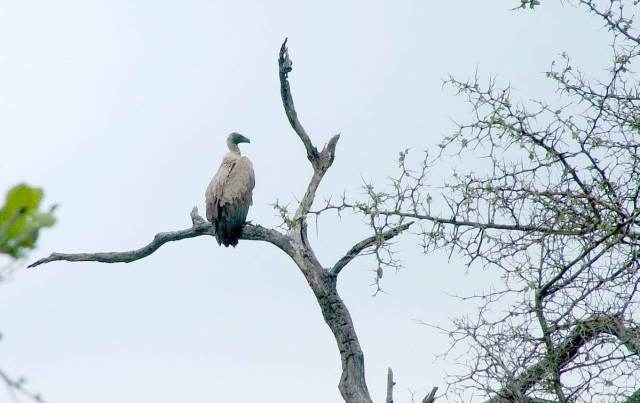Our Visit To Nkumbe Lookout In Kruger National Park

Our drive north from Lower Sabie Rest Camp brought us to one of the most popular lookouts in Kruger National Park, Nkumbe Viewpoint.
There, a simple thatched structure is constructed on a high ridge giving an unparalleled view of the striking lowveld savanna that spreads to the horizon.
After having spent a good block of time at Sunset Dam near Lower Sabie Rest Camp, we took our leave by crossing over the Sabie River and driving north along the Tshokwane-Lower Sabie Road (H10).
This weathered dead tree made the perfect resting spot for numerous White-backed Vultures. I have since learned that these birds, also referred to as African White-backed Vultures, have recently been re-categorized as Critically Endangered, so Bob and I were extremely lucky to come across these few.
Though African White-backed Vultures eat carrion, they often rely on other vultures and scavengers to lead them to animal carcasses. The whitish plumage on the back is what gave this species its name.
Our route was never far from a river, and it was easy to see how washouts could occur during the rainy season. Even though we traveled to South Africa during the very early summer, several times we encountered stretches of dirt road that were under water or at risk of becoming flooded.
Over the miles that we traveled, Bob and I came across some amazing iconic landscape that fulfilled our every expectation of South Africa. On this day, we found that the highway upon which we drove seemed to separate two distinct types of terrain that were in direct contrast to one another.
The countryside on one side of the roadway was a sea of tall, yellow grass,
while on the other, the land was spotted with tufts of green grass and shrubs of varying heights, intermixed with short scrawny trees.
Both types of terrain were rich in wildlife that kept us busy scanning for the next bit of action. A herd of zebras,
numerous kudu,
including this magnificent male…
and elegant female,
elephants, wildebeests, monkeys, warthogs, eland and even a rhinoceros were seen wandering the rough scrubland or seeking shade beneath gnarled mopane or acacia trees. It was everything we expected of Africa.
At some point, Bob and I became aware of a long ridge that looms over the landscape and stretches for miles. It bisects the otherwise vast stretch of flat land that dominates the southern section of Kruger National Park.
As we continued to travel north, we came upon the Nkumbe Viewpoint that is situated on that same ridge. This is one of a few locations within Kruger where visitors are allowed to exit their vehicles, but it is still recommended to be vigilant.
After leaving the car in a small parking lot, we walked a short distance to the simple wooden shelter whose thatched roof provides much-appreciated shade.
As Bob and I appreciated the cool temperature in the shelter, we were in awe of the endless veldt savannah stretching west to the horizon. There in the silence, as brilliant orange blossoms framed the view and sturdy cacti reached for the stars,
we were startled when a large Rock Monitor crept out from under one of the many boulders that littered the area. The Monitor probably lived in a hole beneath one of the rocks as is their custom to do. The creature was 2-3 feet long, but individuals can get as long as 6 feet or more.
The Rock Monitor, also called a White-throated Monitor, must have been intrigued by the piece of nectarine that fell to the ground only seconds earlier. Rock Monitors are the second longest lizard in Africa after the Nile Monitor and are the heaviest lizard species in Africa. Having had this lizard make a sudden appearance reminded Bob and me that we could never let our guard down because unknown creatures are always lurking in the bushes. Some people had seen a Lion cub in the long grass at the entrance.
A short while later, when Bob edged the car back onto the roadway, we spotted on the opposite side of the road a family of Klipspringers. Three small, sturdy antelopes were keeping dutiful watch as we pulled over to photograph them, yet another species of animal in the vast array that inhabit Kruger National Park.
Our drive from thereon back to Skukuza Rest Camp traversed terrain studded with massive rocks and boulders. In some cases, a house-sized boulder sat balanced on another of comparable size, and huge deposits of boulders resulted in towering ridges and hills.
And then, back at our hut, we were greeted by a family of Vervet Monkeys. There was never a dull moment in or out of the Park.
Related:























